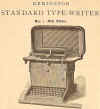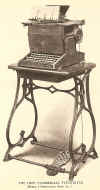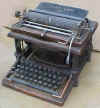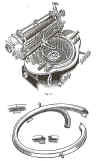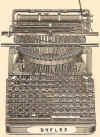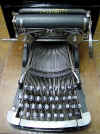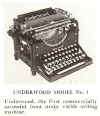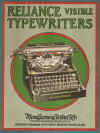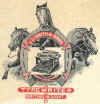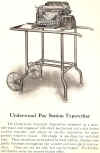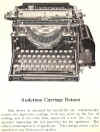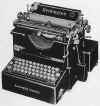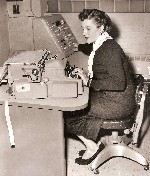Early Office Museum
Antique Office Typewriters

This Museum gallery covers the early typewriter models that were most prevalent in offices: Upstrikes, Hammonds, Front Strikes, Olivers and, later, Electric Front Strike typewriters, and IMB Selectrics. For convenience the gallery includes a few models that probably did not have substantial sales to offices (National and American upstrikes and Daugherty/Pittsburg, Jackson, and Standard Folding/Corona front strikes). Special purpose office typewriters and other typewriters are discussed and illustrated on subsequent web pages. The see them, click on the "Next" link at the top of this page.
General Purpose Office TypewritersUntil the 1960s, the most common office typewriters were sturdy keyboard machines that used type-bars. Until the first years of the 20th century, the office standard was the upstrike typewriter. During the 1900s-1950s, the standard was the front strike typewriter. However, the downstrike Oliver was also popular during the first quarter of the 20th century. |
|||||||||||||||||||||||||||||||||||||||||||||||||||||||||||||||||||||||||||||||||||||||||||||||||||||||||||||||||
|
|
Upstrike
Typewriters with Single Keyboards During the late 1860s and early 1870s, Christopher L. Sholes and
collaborators invented the first practical typewriter, which was produced by E. Remington & Sons
and sold as the Sholes
& Glidden Type Writer during 1874-78. (See advertisement to the right.) The earliest Sholes & Gliddens
were mounted on sewing machine stands, and their carriage returns were
operated by foot treadles. Sholes & Glidden machines typed only upper case letters.
Approximately 5,000 were sold. For superb photographs of a Sholes & Glidden
sold by Auction Team Köln, click here. The Sholes & Glidden was an upstrike
typewriter, so named because the type struck the bottom
of the platen from below. The operator of an upstrike could not
see what was typed without stopping and swinging the hinged carriage upward. |
|
|||||||||||||||||||||||||||||||||||||||||||||||||||||||||||||||||||||||||||||||||||||||||||||||||||||||||||||||
|
|
Upstrike
Typewriters with Single Keyboards The Remington No. 2, introduced in
1878, typed both lower and upper case letters. Each key on a Remington
No. 2 upstrike typewriter is attached to a long horizontal lever. Also
connected to the lever is one end of a vertical wire, the other end of
which is attached to one end of a type-bar. The opposite end of the type-bar
carries the type (both an upper case letter and a lower case letter). When the operator depresses a key, this forces down the
attached horizontal lever, pulls down a vertical wire, and hence pulls
down one end of a type-bar. The type-bar pivots, and the end
with the type swings upward, hitting the ribbon, paper, and platen
from below. In order to type an upper case letter, the operator touched a
shift bar. At rest, the type-bars hang downward and form the
periphery of a vertical cylinder. Mares (1909, pp. 58-59) states that "The No. 2 Remington seemed for a long time to be all that could be looked for in a typewriter. Considerably over 100,000 machines of the No. 2 model were sold. Many of them are in constant and heavy use to-day." The No. 2 and succeeding Remington typewriters had a single keyboard, that is, a single key for each letter and a shift key to switch between lower case and capital case letters. While the No. 2 had both capital and lower case letters, the No. 4 had only capital letters. Numerous other upstrike machines with a single keyboard were produced by Remington's competitors. These include the single keyboard version of the International Typewriter (1889), the Densmore Typewriter (1891), the Rem-Sho Typewriter (1896)/Fay-Sholes Typewriter (1901), and the Fox Typewriter (1898). A photo in the May 1900 issue of The Typewriter and Phonographic World shows 40 Densmore typewriters in use in an office at the Fred Macey Co., a furniture producer in Grand Rapids, MI. {To be added: Monarch, photos of additional upstrike brands} On the single keyboard International, each key controlled two type-bars, for example, one type-bar with an upper case "E" and the other with a lower case "e." When the operator depressed the shift key, the cylindrical set of type-bars rotated so that the upper case type-bar took the position of the lower case type-bar. The National Typewriter (1889) has two shift keys that move the keyboard and type basket forward and backward so that each regular key is used to type both the upper and lower cases of a letter as well as a number or symbol. The National was smaller and lighter (13 lb.) than the typical upstrike machine, and we have not seen evidence that the National had significant sales to offices or business schools. The American Typewriter (1901) is a relatively simple upstrike machine. Each key is connected by a rod to the corresponding type. When a key is struck, the rod pivots, and the type strikes the underside of the platen. {Add photo} |
|
|||||||||||||||||||||||||||||||||||||||||||||||||||||||||||||||||||||||||||||||||||||||||||||||||||||||||||||||
|
Upstrike Typewriters with
Full Keyboards A typewriter with a full keyboard has a separate key for each upper case letter, lower case letter, number and symbol. The Caligraph (1880): With the exception of the No. 1, which has only capital letters, the Caligraph has separate keys for the upper and lower cases of each letter. The lower case keys, numbers, and symbols are located in the center of the keyboard; the upper case keys are located to the left and right sides. In front of the keys is a sloping shelf; inside this part of the machine are levers that transmit the movement of the keys to the type-bars. The sloping shelf in front of the keyboard was dropped when the company began marketing the New Century Caligraph in 1898. In 1888, Caligraph claimed that 20,000 and then 30,000 of its machines had been sold since 1880. Just one year later, Caligraph began to claim that 100,000 of its machines had been sold since 1880, and Caligraph continued to make this claim through 1892. The Caligraph was used in offices, but Mares (1909, p. 76), referring to Caligraphs with both upper and lower case type, reports that "the Caligraph was too large and unwieldy an instrument to secure the highest degree of popularity." Other upstrike typewriters with full keyboards include the
Yost (1887), Smith Premier (1889),
full keyboard version of the International
(1889), and Hartford (1894). Unlike the The Duplex Typewriter (1894) was a full keyboard machine.
It had duplicate sets of keys for the lower-case alphabet, one set for
each hand. It Mares (1909, p. 50) reports that "given an average all round class of general work, the use of the shift key machines is to be preferred: but where figures and capitals follow in frequent succession, as in accounts and tabular work generally, then very much is to be said in favour of the double keyboard arrangement." |
|
|||||||||||||||||||||||||||||||||||||||||||||||||||||||||||||||||||||||||||||||||||||||||||||||||||||||||||||||
|
|
Hammond Single-Element Typewriter The Hammond Typewriter was introduced in 1884. E. H. Beach, Tools of Business, 1905, states that "The first official public appearance of the Hammond was at the New Orleans Centennial Exposition in 1884-85, where it came in competition with the Remington and the Caligraph, and won the Gold Medal." Hammonds do not use type-bars. Rather, all the type is on a C-shaped rubber type-shuttle. (See illustrations at bottom left and at right. On the No. 1, the type-shuttle is in two pieces. See illustration at left.) When a key is struck, the type-shuttle rotates so that the desired letter is positioned in front of the paper. A hammer located behind the paper then moves forward and, from the rear, drives the paper against the ribbon and the type. See image top right, which shows the rear of the machine and the "hammer." Over 100 different type-shuttles were available for the Hammond, and the operator could easily change fonts and languages. In 1888, Hammond also advertised metal faced type-shuttles for use in typing manifolds, or multiple carbon copies. In 1887, Hammond advertised that its cumulative sales exceeded 4,000 machines. The top three machines to the left and the top machine in the 1915 image to the right have Hammond's curved Ideal keyboard. The second machine to the right has Hammond's Universal keyboard. The Universal keyboard was set up with the QWERTY arrangement, but the type-elements and the finger pieces on the keys could be changed to accommodate other keyboard arrangements. The Hammond No. 2, which was introduced in 1895, was advertised as being "For all regular mercantile, manufacturing, and professional work." It weighs 19 lb., including its wood case. The Hammond No. 3, which was introduced in 1896, was like the No. 2 but had a line length of 11.3" rather than 8.5". In 1900, Hammond was also selling an aluminum No. 2 designed for travelers, as well as Models 3 through 8. The No. 4 and No. 5 were like the No. 2 but had special features. The No. 4 printed fewer characters per inch, to make documents easier to read, and was aimed at people who would read their texts out loud. The No. 5 printed Greek letters. The No. 6 through No. 8 machines were wide-carriage typewriters aimed at commercial and government offices. The 16"-carriage Model 6 was marketed to banks and insurance companies. The 20"-carriage No. 7 was marketed to "banks, railroads, steamship companies, insurance companies, government departments, and other large commercial interests, for the marking of abstracts, wide tabulated matter, financial reports, etc." The 30"-carriage No. 8 was intended for the "largest and most intricate tabulated work, statistical tables, etc." (Quoted in ETCetera, Issue 17, Dec. 2001, from a 1900 catalog.) The fact that Hammond produced wide carriage machines intended for use in offices supports other evidence indicating that Hammonds were used in some offices, although we have not seen them in early office photographs, and the wide carriage models are now rare. Hammond introduced the No. 12 in 1905 and the Multiplex, which had two shuttles, in 1913. Early Hammond advertisements claimed that typists using Hammonds had won numerous typing speed contests. Hammond machines sold well and were produced until 1927. Machines based on the Hammond design were sold under the Varityper name from 1927 until the 1970s. Vari-Typers were not ordinary typewriters but composing machines that made professional looking camera-ready masters for offset (photo-lithographic) duplication. As on the Hammond, one could easily change the type-shuttles on the Vari-Typer to type in different fonts and languages. The Vari-Typer added right justification (1937), variable letter spacing (1947), and variable line spacing (1953). For further information, see our exhibit on Special Purpose Typewriters. |
|
|||||||||||||||||||||||||||||||||||||||||||||||||||||||||||||||||||||||||||||||||||||||||||||||||||||||||||||||
|
|
Front Strike Visible
Writing Machines On front strike typewriters, the type-bars strike in full view against the front of the platen. As a result, these are visible typewriters. The Daugherty Visible (1893)/Pittsburg Visible (1898) was the first front strike machine. It was not a practical office typewriter because its long type-bars made alignment difficult to maintain. Nevertheless, ads claimed Daugherty machines were sold to the US government, railroads, and other corporations. The keys and type baskets (type-bar assemblies) on the Daugherty and Pittsburg Visible could be replaced easily to permit typing in a different font or language. See photo top right. The Daugherty typewriter weighs 16 lb. Front strike brands that were suitable for use in offices included the Underwood Typewriter (1895), Monarch Typewriter (1904), L.C. Smith & Bros. Typewriter (1904), Royal Typewriter (1906), Remington No. 10 Typewriter (1908), and Smith Premier No. 10 Typewriter (1908). The last of these still had a double keyboard. In 1910, Smith Premier advertised that 400,000 of its machines (including upstrike and front strike models) were in use. The Underwood No. 3, which had a wide carriage, was marketed as a Billing Typewriter. The standard size Underwood No. 5 weighs 30 lb.
{Add paragraph on Sun No. 2} The Standard Folding Typewriter (1908), a 5.5 lb portable, was the predecessor of the Corona Typewriter (1912), which was also a folding portable. Production of the Standard Folding totaled about 27,000 machines during 1908-12, and production of the Corona totaled about 673,000 machines during 1912-41. (ETCetera No. 22, March 1993) Rehr reports that the Corona was the portable typewriter worldwide until the early 1920s, and that a large share was exported. The Corona's first major direct competitor, the Underwood Standard Portable, was introduced in 1919. (Ed Neuert, ETCetera No. 77, Mar. 2007. (D. Rehr, ETCetera, Issue 11, June 1990) {Add paragraphs on Harris Visible, Reliance, Remington Rand Noiseless} |
|
|||||||||||||||||||||||||||||||||||||||||||||||||||||||||||||||||||||||||||||||||||||||||||||||||||||||||||||||
|
|
Downstrike Visible
Typewriters The Oliver Visible Typewriter (1893) is a distinctive downstrike visible typewriter with a double shift key. Half the inverted-U-shaped type-bars are nested over the carriage on each side of the machine. They strike downward on the top of the platen. Oliver typewriters excelled at stencil cutting, could be used to produce as many as twenty carbon copies, and were widely used in offices. The No. 2 model (1896-1900), which was sold with dark green paint or nickel plating for $95, was the company's first commercial success; 30,000 were sold by the time the No. 3 was introduced. (Peter Weil, ETCetera No. 77, Mar. 2007) In April 1900, Oliver claimed "22,000 converts in thirty months." More than 1 million Olivers were produced in the US during 1893-1926, and they were produced in England after US production ceased. Around 1903, an Austrian company began production of the Courier under a license from Oliver. The photograph top right shows a public stenographer using an Oliver typewriter c. 1900. In 1890, it was reported that "So dependent have the merchants become upon the type-writer that in no less than ten of New York's hotels type-writer operators find a profitable business in doing the correspondence of guests." (Catalogue of the Albany Business School, Albany, NY, 1890, p.28) Harper's New Monthly (June 1898, p. 145) tells of a public stenographer whose price for typing a dictated letter was 15 cents. Until 1910, the Oliver was $100. A 1914 ad for the Oliver No. 3 stated that "Starting in a small way in 1910, our direct-to-the-user plan of selling typewriters [at a lower price] met with immediate response. Over 15,000 of our Model No. 3 Olivers are today giving supreme satisfaction." In 1914, the Oliver No. 3 was sold direct for $58.50. Also in 1914, the company stated that its machines were "used in 183 different railroad offices. Two of the largest mail-order houses in the world each use over 1,000." One of those mail-order houses was Sears, Roebuck & Co. See photo to right. The Oliver No. 7 weighs 29 lb. |
|
|||||||||||||||||||||||||||||||||||||||||||||||||||||||||||||||||||||||||||||||||||||||||||||||||||||||||||||||
|
Original Prices of Upstrike, Hammond, Front Strike and Oliver Typewriters
|
|||||||||||||||||||||||||||||||||||||||||||||||||||||||||||||||||||||||||||||||||||||||||||||||||||||||||||||||||
|
Wide Carriage Typewriters Many brands of office typewriters were offered with wide carriages for use in typing on wide sheets of paper, including business forms. Some typewriters were offered with interchangeable carriages of different lengths. |
|
||||||||||||||||||||||||||||||||||||||||||||||||||||||||||||||||||||||||||||||||||||||||||||||||||||||||||||||||
|
Coin-Operated Typewriters According to a December 1934 article in Automatic Age, coin-operated typewriters were designed for use by travelers at hotels but were soon installed in "libraries, YMCAs, YWCAs, nurses homes, university districts, boats, trains, department stores, clubs, and various other places equally profitable." This same article announced the introduction of the Type-O-Meter by the General Coin-Automatic Co., San Francisco, CA. This device had been test marketed in a few cities during the preceding two years. The Type-O-Meter "consists of a small and compact steel box which is attached to the right side of a standard typewriter in which is located a time controlled locking mechanism that permits use of the typewriter for half an hour upon depositing of a ten cent piece." According to a January 1933 article in the same magazine, coin-operated typewriters had recently been installed in some German post offices. |
|
||||||||||||||||||||||||||||||||||||||||||||||||||||||||||||||||||||||||||||||||||||||||||||||||||||||||||||||||
|
|
Electric Typewriters A 1930 discussion of electric typewriters explains that "On a hand-operated machine the operator must furnish the power to operate the type bars, the line spacer, the back spacer, the carriage return, the shift keys, and the shift lock. On the motorized machine the operator touches a key to indicate the operation to be performed, and the power to perform the actual operation is supplied by an electric motor. On some machines, the motor actuates the type bars only; on others the power is applied to all of the operations of the machine as described above." (American Technical Society, Practical Business Administration, Vol. IX, 1930, pp. 70-71.) The Cahill, essentially an electric version of the Remington No. 2, was introduced in 1899. The sub-levers, spacebar and line spacer were electrically powered. Few of these machines were produced. The Blickensderfer Electric was introduced in 1902. Rotation of the type-wheel, backspacer, line spacer, and margin stop were powered by an electric motor. It was $125. It is reported that the machine was marketed for 15 years. (ETCetera, No. 33, Dec. 1995) The German Mercedes Electra typewriter was marketed in 1921. The similar Woodstock Electrite, which had a small "outboard" motor, was introduced in 1924 and was still advertised in 1928. On both machines, only the type-bars and shift keys were powered by the motor. The carriage return was manual. The Remington Electric was introduced in 1925; the type bars, shift keys, shift lock, tabular key, back spacer, line spacer, and carriage return were all powered by a rotating cylinder driven by an electric motor. The typewriter was based on the Remington No. 12. The motors were made by the North East Electric Co. Only 2,500 of these machines were produced. Remington Electrics could be connected in series; an operator would type on the first machine and the other machines would repeat the actions simultaneously. In 1927, electric Vari-Typers were introduced. The motor supplied the power to drive the hammer forward against the type and to advance the carriage, while the rest of the machine remained manual. The North East Electric Co.'s Electromatic Typewriter (1929/30) was based on the same patents as the Remington Electric. The Electromatic was $250. (R. Sobel, IBM, 1981, p. 82) This business was then spun off as the Electromatic Typewriter Co. In 1933, International Business Machines (IBM) purchased the Electromatic Typewriter Co. and introduced the IBM Electromatic. The machine was $225. IBM introduced the IBM Electric Hektowriter c. 1938; other early IBM electrics were the Toll Biller, Manifest Writer, and Automatic Formswriter. Because the type-bars struck with more force than was possible with a manual typewriter, the IBM Electromatic was popular for filling out thick multi-page forms. Another early electric typewriter was the Burroughs Electric Carriage Typewriter (1932). The electric motor powered only the carriage return. A retrospective review of the fully manual Burroughs Standard Typewriter, to which the electric carriage return feature was added, gave it low marks. (Will Davis, ETCetera No. 76, December 2006) Electric typewriters accounted for only a small share of all typewriters used in offices until after World War II. During the late 1930s, IBM sold around 6,000 electric typewriters annually and accounted for about 5% of total (manual and electric) new typewriter sales. (Sobel, p. 82) Because of the relatively long life of typewriters, IBM's share of all typewriters in use in offices in the late 1930s was miniscule. |
|
|||||||||||||||||||||||||||||||||||||||||||||||||||||||||||||||||||||||||||||||||||||||||||||||||||||||||||||||


